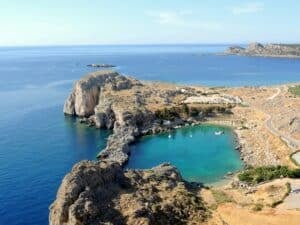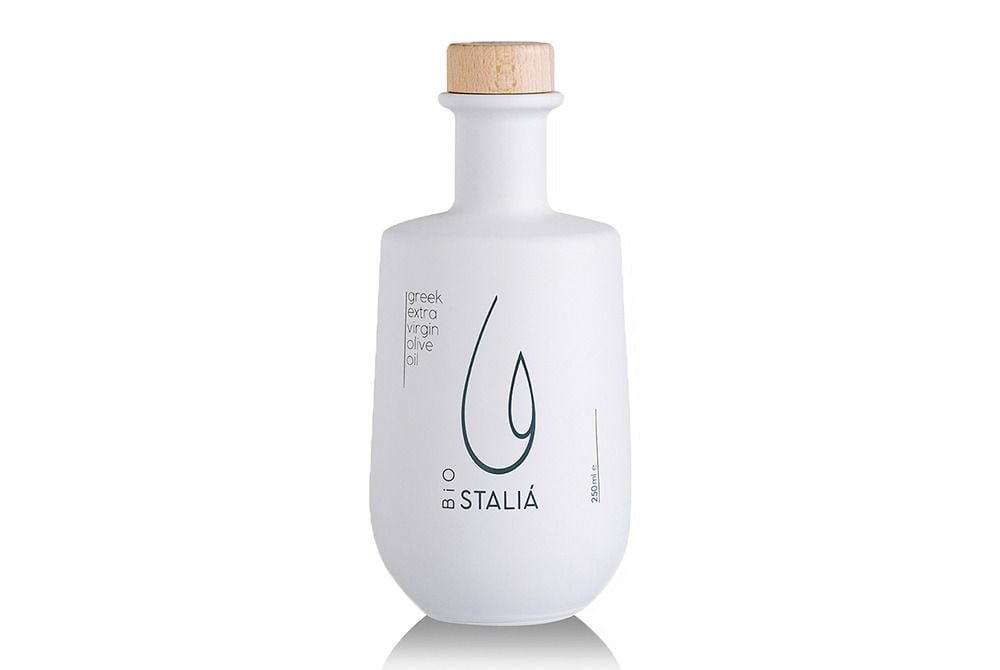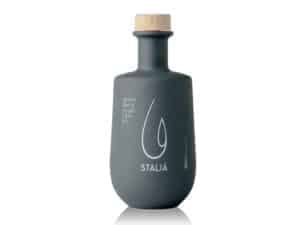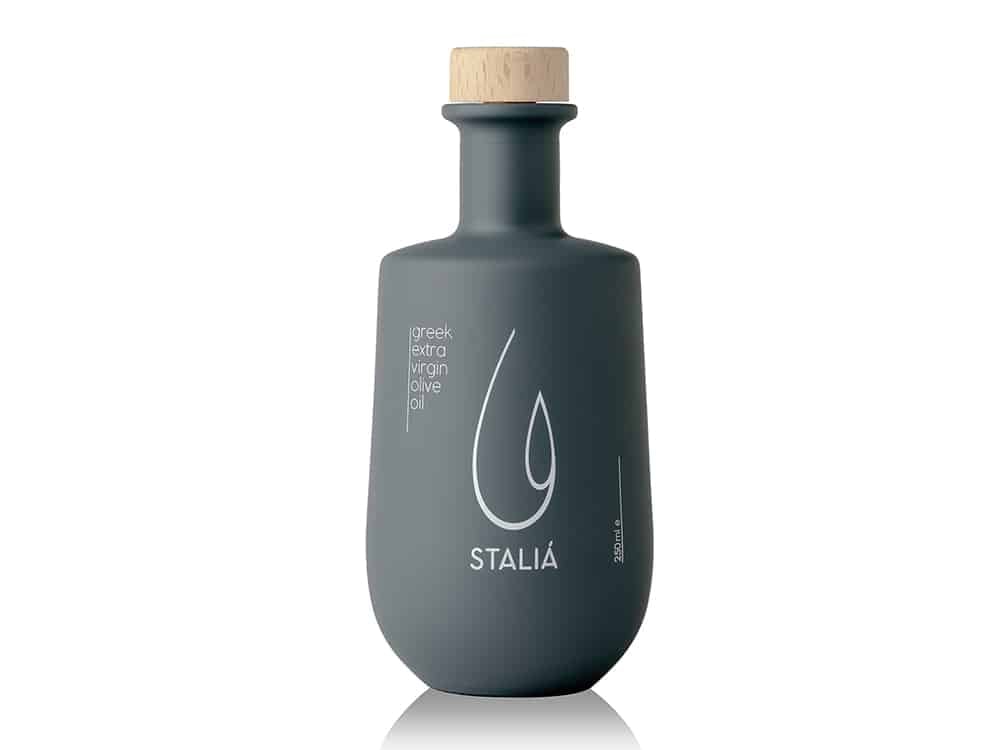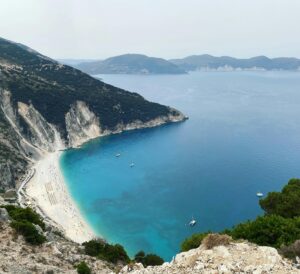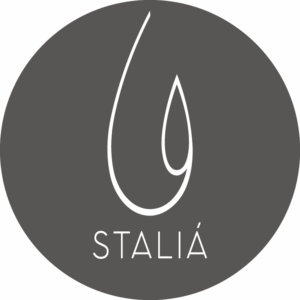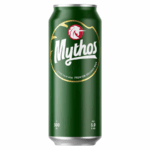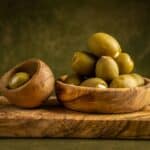Technical analysis of Stalia olive oil - Athens
Stalia is a premium extra-virgin olive oil made exclusively from the Koroneiki variety, harvested at an early stage in the Messinian region of southern Peloponnese. This area is renowned for its well-drained clay-limestone soils, temperate Mediterranean climate and thousand-year-old olive-growing tradition, which favors polyphenolic concentration and control of water stress.
Although the full analytical spectrum has not yet been officially published, the technical analyses of Stalia olive oil can be partially deduced from several correlated elements. Its cold extraction, combined with rapid post-harvest pressing, ensures low enzymatic oxidation, essential for preserving water-soluble phenols such asoleacein andhydroxytyrosol.
At the same time, Stalia boasts an organoleptic profile typical of very early-harvested Koroneiki: expressive green fruitiness, harmonious spiciness and slight vegetal bitterness, often sought after in tasting panels certified by the International Olive Oil Council. This clean, well-structured olfactory profile has already been recognized by several international juries. In 2023, Stalia won a gold medal at the NYIOOC and a double Platinum & Gold award at the London IOOC, competitions which include rigorous sensory analysis grids aligned with IOC standards.
So, despite the temporary absence of a public HPLC or NMR report, technical analyses of Stalia olive oil can be assessed according to professional criteria based on its terroir, extraction process, variety, sensory profile and track record. This article is intended for jurors, oil sommeliers, specialized buyers and producers, to enrich the analytical reading of this promising oil.
Origin & terroir of Staliá olive oil
A temperate marine terroir with ideal agroclimatic conditions
Staliá Olive Oil has its roots in Gargaliani, in western Messinia, a micro-region of the Peloponnese particularly suited to precision olive growing. Situated at a low altitude, but in the immediate vicinity of the Ionian coastline, this area enjoys a temperate Mediterranean climate, with mild winters, hot but breezy summers, and rainfall distributed throughout the agricultural year.
The constant sea breeze, generated by the proximity of the Ionian Sea, plays a crucial role in summer thermal regulation. It limits excessive water stress, improves foliage aeration, and slows the development of certain fungal diseases. This natural ventilation also contributes to the slow synthesis of secondary compounds, such as volatile alcohols and aromatic esters, essential for the final olfactory profile.
In addition, the region’s well-structured clay-limestone soils ensure good drainage while retaining the moisture necessary for the root system to develop properly. This soil typology favors the minerality perceptible in certain oils, notably via discrete olfactory markers (raw beans, chalky notes, mild salinity), characteristics frequently observed in technical analyses of Stalia olive oil.
Finally, the combination of the Koroneiki variety with this marine terroir creates a unique signature. Gargaliani‘s microclimate, rarely subject to extreme variations, allows gradual ripening, a fundamental factor in the balance between polyphenol content and aromatic freshness.
Clay-limestone soil structures the aromatic profile
Technical analyses of Stalia olive oil must take into account the nature of the soil, as its impact on biochemical composition is decisive. In Western Messinia, Koroneiki olive trees take root in a deep clay-limestone mixture, typical of the low hills of Gargaliani.
On the one hand,clay provides good mineral retention, while modulating water availability. On the other hand, active limestone, which is very present in this terroir, helps regulate rhizospheric pH, essential for optimal potassium and calcium absorption. This often overlooked mineral ratio influences enzyme mobilization in the fruit, particularly during the veraison phase.
Thanks to this combination, the soil favors moderate but constant water stress, which stimulates the synthesis of secoiridoids such as oleuropein and its derivatives (oleacein, oleocanthal). This factor partly explains the high phenolic density generally observed in oils from this zone, even without intensive irrigation.
In addition, this type of well-drained soil avoids root saturation, limits the risk of cryptogamic diseases, and favors aeration. All these parameters lead to a slow but highly expressive ripening process, reflected in a clear and reproducible sensory complexity in the technical analyses of Stalia olive oil.
Altitude and exposure: two climatic levers for optimal concentration
Technical analyses of Stalia olive oil must take into account an often underestimated parameter: the combination ofmoderate altitude andsouthern orientation of olive groves located between 100 and 300 meters above sea level, in the Gargaliani region.
This topographical configuration plays a direct role in the ripening kinetics of Koroneiki olives. At this altitude, the thermal differential between day and night remains sufficiently marked to induce mild thermal stress, favorable to the biosynthesis of volatile and phenolic compounds. This phenomenon, well documented in precision olive growing, intensifies the production of lipoxygenases, key enzymes in the LOX pathway involved in herbaceous aromas.
In addition, full southern exposure ensures intense sunlight, essential for efficient photosynthesis in the early stages. This direct light accelerates the conversion of sugars into fatty acids, while activating the fruit’s natural protection mechanisms – resulting in increased antioxidant content, notably tyrosol, oleuropein and hydroxytyrosolic derivatives.
Last but not least, the south-facing slopes ensure natural drainage of the plots and limit stagnant humidity, thus reducing the risk of cryptogamic diseases. The impact of these combined factors is reflected in the technical analyses of Stalia olive oil: a balanced, stable oil, with a clean green fruitiness rarely found at lower altitudes.
Mediterranean flora and biodiversity: a functional ecosystem at the service of quality
As part of the technical analysis of Stalia olive oil, the presence of an active plant and entomological ecosystem is an indirect but revealing indicator of the orchard’s agroecological quality.
Around Koroneiki olive trees, the spontaneous Mediterranean flora of thymus capitatus, lavandula stoechas, rosmarinus officinalis and other aromatic species plays a key role. These plants naturally produce volatile terpene compounds, some of which can migrate into the lipid fraction of olives through molecular cohabitation or via pollinating insects, a phenomenon known as terroir biosignature.
What’s more, the total absence of intensive cultivation and chemical inputs encourages a high level of entomological diversity. Wild bees, hoverflies, ladybugs and parasitoid wasps not only ensure cross-pollination, but also natural pest control, limiting the need for corrective treatments.
This stable plant context also acts as a positive microbial reservoir for the roots, with mycorrhizal symbiosis facilitating the absorption of micronutrients. This direct link between functional biodiversity and the physiological resilience of olive trees contributes to the stability of the phenolic profile, a crucial element in the technical analysis of Stalia olive oil.
Variety & Harvesting Olives
Monovarietal Koroneiki: the cornerstone of technical analysis for Stalia olive oil
As part of the technical analysis of Stalia olive oil, the choice of the Koroneiki variety is a strategic one. Endemic to Greece and particularly widespread in the Peloponnese, Koroneiki is characterized by an exceptionally high content of biophenols, notablyoleocanthal,oleacein andoleuropein aglycone.
Koroneiki fruits, small in size (1 to 2 g on average), have a thick skin rich in water-soluble phenolic compounds, which favors a higher concentration of antioxidants even when harvested early. Their high flesh-to-stone ratio also optimizes the ratio between extracted fat and retained bioactive compounds. This dense morphology, coupled with a high natural content of monounsaturated fatty acids (notably oleic acid), gives the oil remarkable oxidative stability, verifiable via indices such as peroxide (PV) orRancimat oxidation induction.
Moreover, Koroneiki’s physiological resilience to abiotic stresses (prolonged drought, saline winds) and to certain cryptogamic pathologies reduces the need for phytosanitary intervention. This enables low-impact cultivation, while preserving the organoleptic characteristics of the fruit.
Finally, its sensory profile is perfectly suited to premium markets: Koroneiki develops a clean bitterness, a long-throat spiciness and an intense green fruitiness, sought after by professional panels and valued in competitions such as NYIOOC or Olive Japan. In technical analyses of Stalia olive oil, this variety becomes an analytical and taste benchmark.
Early harvesting and phenolic biosynthesis in the technical analysis of Stalia olive oil
In the technical analyses of Stalia olive oil, the choice of harvesting as early as October is a critical differentiating factor. At this stage, known as partial veraison, the fruit retains a predominantly green, even slightly turning color. This period corresponds to the peak of enzymatic activity in the production of biophenols, notably oleocanthal and oleacein.
Early harvesting preserves optimal phenolic density, before enzymatic ripening processes dilute these key compounds. What’s more, the more moderate temperatures of early autumn slow down lipid oxidation, improving the stability of the sensory profile.
Organoleptically, the oils from this phase are distinguished by frank aromas of olive leaf, freshly cut grass and even raw artichoke. The bitterness is clean but elegant, while the spiciness rises gradually, reaching the back of the throat. This type of structure is typical of the early-harvest oils valued in professional sensory panels.
From an analytical point of view, this harvesting strategy maximizes the chances of exceeding the 250 mg/kg polyphenol threshold required for the European health claim. It also results in a more stable chemical composition, with high levels of bioactive secoiridoids, while maintaining low free acidity. This is a central parameter in the evaluation grid of a technical jury or a demanding importer.
Selective hand-picking: a quality lever in the technical analysis of Stalia olive oil
In the technical analysis of Stalia olive oil, the harvesting method plays a fundamental role in preserving chemical and sensory parameters. The olives are exclusively hand-picked, a demanding method that enables immediate selection on the tree. This gentle harvest limits mechanical shocks, which are often responsible for micro-cracks that encourage undesirable enzymatic phenomena such as lipolysis or anaerobic fermentation.
Sorting is carried out directly at the point of harvest. Only intact fruit, free from insect bites, mold or visible bruising, is kept. This rigorous process excludes any altered plant matter likely to increase free acidity or generate sensory defects (musty, rancid, earthy) detectable by an IOC panel.
By drastically limiting oxygen exposure and peroxidation mechanisms, this protocol significantly improves the results of analyses such as the peroxide index, K232 and K270. It also helps maintain a stable polyphenolic load, preserving the volatile molecules responsible for the vegetal nose, a typical signature of early-harvest Koroneiki.
This artisanal approach, though labor-intensive, is a guarantee of quality recognized by sensory experts and international competition juries. It places Stalia olive oil on a qualitative footing, with each stage of the process designed to safeguard the product’s biochemical integrity.
Optimized yield for quality: a technical hallmark of premium oils like Stalia
In the technical analysis of Stalia olive oil, the ratio of olives to oil is a strategic indicator. It takes between 7 and 9 kg of olives to produce a single liter of extra virgin oil, placing Stalia in the category of low-yield, high-functional-intensity oils. This choice is not a constraint, but a conscious agronomic and qualitative decision.
This deliberately low yield is the result of early harvesting, when the olives are still green or turning. At this stage, water content is lower, but the concentration of secondary metabolites, notably polyphenols, peaks. Oleocanthal, oleacein, tyrosol and ligstroside aglycone are generally over-represented in this type of profile. This translates into a higher antioxidant density, measurable by HPLC or NMR, and sought after in functionally-oriented competitions such as the Olympia Health Awards.
From a sensory point of view, this tight yield also favors a concentration of volatile plant aromas: olive leaves, raw artichoke, fresh grass, green tomato. These compounds, often soluble in the oil phase, are best expressed when the fruit has not yet reached fat maturity.
This type of olive/oil ratio is also associated with a high load of oleuropein aglycone, known for its synergy with secoiridoids and its stabilizing effect on the organoleptic profile over time. Stalia’s choice is therefore in line with the end-to-end quality logic of the best extra-virgin olive oils with a proven analytical profile.
Technical analysis of Stalia olive oil
Extraction Method: Millimetre Precision
Two-phase extraction: a crucial technological choice for phenolic preservation
In the technical analysis of Stalia olive oil, the use of a two-phase extraction system, without the addition of hot water, was a decisive decision. This process, still rare in Greece but prized by demanding producers, respects the structure of water-soluble biophenols, notably hydroxytyrosol and its derivatives.
Indeed, the addition of water in the mixing phase, common in three-phase systems, induces a notable loss of antioxidant compounds in the margines. In contrast, the two-phase system maintains a denser emulsion, preserving secoiridoids such as oleacein, as well as secondary flavonoids such as luteolin and apigenin.
This choice also has an environmental impact. Waterless extraction drastically reduces the production of liquid effluents, which are responsible for local pollution in conventional mills. It is part of a sustainable agro-industrial approach, which values ecological performance as much as analytical performance.
From a functional point of view, oils derived from this type of process generally show better oxidative stability (low peroxide index) and longer aromatic density in retro-olfaction. Stalia’s profile, as suggested by its awards and the standards of the early-harvested Koroneiki variety, testifies to an excellent ratio of total polyphenols to oxidizability.
Finally, this extraction method complies with the technical recommendations of the International Olive Oil Council (COI/T.15/NC No 3), and is a prerequisite for oils wishing to compete in the health/nutrition categories on the international stage.
Blending temperature: a decisive criterion in the technical analysis of Stalia olive oil
In the technical analysis of Stalia olive oil, strict adherence to a blending temperature below 26°C is a fundamental choice. This limit, well below the legal threshold of 27°C set for cold extraction, guarantees the preservation of volatile aromas, which are often sensitive to heat.
Low-temperature mixing limits evaporation of the aldehydes, alcohols and esters responsible for the herbaceous, floral and fruity notes. In the case of an early-harvest Koroneiki like Staliá, this maintains the typical aromatic signatures of tomato leaf, green almond or green banana.
This thermal rigor also influences the stability of pigments, in particular chlorophyll and carotenoids. These compounds, naturally present in olives that are still green, not only ensure a golden hue with green highlights, but also help protect against light oxidation.
From a functional point of view, temperature-controlled oils have lower peroxide values, higher concentrations of oleuropein aglycone, and greater overall antioxidant potential. These elements reinforce the product’s nutritional value and justify its positioning in premium circuits.
In Staliá’s production methodology, this meticulous control of the blending process is a hallmark of quality. It testifies to our determination to produce a highly expressive extra virgin olive oil that meets the requirements of sensory panels and international competitions.
Post-harvest speed: a critical lever in the technical analysis of Stalia olive oil
In the technical analysis of Stalia olive oil, the control of post-harvest time plays a key role. The time between hand-picking and extraction never exceeds four hours. This extremely short time drastically limits enzymatic oxidation phenomena, in particular the activity of lipoxygenases, responsible for the early degradation of aromas and the instability of fatty acids.
This meticulous logistical organization preserves the cellular integrity of the fruit, encourages the release of the noblest volatile compounds, and prevents the rise of sensory defects typical of stored olives (musty, earthy, vinous).
At the same time, this speed helps maintain a clear aromatic density, with volatile markers still intact at the time of crushing. Notes of green leaf, artichoke, raw almond or fresh grass are thus amplified, reinforcing the Koroneiki varietal profile in a legible and reproducible way.
Last but not least, this speed requirement goes hand in hand with a protocol in which each stage remains manually supervised. No automation takes the place of human observation, particularly during sorting, transport or filling of the mixer. This rigorous craftsmanship ensures constant quality control and prevents any thermal or mechanical drift.
This rapid yet controlled process is a central pillar of the Staliá approach. It gives the oil a high level of sensory stability, a pure olfactory signature, and the reproducibility expected by competition juries, olive oil sommeliers and professional buyers.
Natural decantation: a strategic choice in the technical analysis of Stalia olive oil
When it comes to the technical analysis of Stalia olive oil, the choice of natural decantation is a decisive step. Unlike aggressive mechanical filtration, often used to speed up bottling, Staliá favors a slow process based on gravity sedimentation. This gentle method, with no centrifugal force or pressure filtration, preserves a precious molecular balance.
This absence of mechanical filtration prevents the loss of beneficial micro-particles, often rich in flavonoids and hydrophilic polyphenols, notably hydroxytyrosol, pinoresinol and traces of apigenin. These secondary compounds play a crucial role in the oil’s oxidative stability, viscosity and documented protective effect.
In addition, this artisanal approach helps maintain the naturally silky texture characteristic of well-worked Koroneiki oils. The palate is fatty but precise, without heaviness, with a balanced coating that prolongs tactile sensations without saturating the palate.
This sensory structure reflects a fine mastery of decantation, a parameter rarely standardized, but essential in top-of-the-range oils. The residual presence of unfiltered phenolic compounds partly explains Staliá’s remarkable resistance over time: the oil retains its freshness, clarity and intensity several months after opening, an advantage recognized by sommeliers and functional evaluation juries.
Natural decanting is therefore an integral part of Staliá’s strategy of preserving quality, while reinforcing its positioning as a functional, artisanal and technically credible olive oil.
Storage & Packaging - Total Quality Preservation
Inert atmosphere storage: a fundamental lever in the technical analysis of Stalia olive oil
In technical analyses of Stalia olive oil, post-extraction management is a critical factor that is often underestimated. Immediately after crushing, the oil is transferred to tanks made of AISI 304 stainless steel, a perfectly neutral food-grade material. This choice eliminates any risk of chemical interaction, protecting the lipid phase and sensitive bioactive compounds.
Each vat is housed in a temperature-controlled chamber, maintained at between 16 and 18°C. This temperature range is not chosen at random. As soon as the temperature rises above 20°C, the oxidation rate of oleic acid increases significantly. As a result, volatile aromas lose their sharpness, polyphenols degrade more rapidly, and vegetal freshness gradually diminishes.
At the same time, the headspace of each tank is saturated with nitrogen gas. This inert gas effectively replaces oxygen, reducing oxidative activity to a minimum. This technique, known as inerting, blocks auto-oxidation reactions and slows the formation of primary peroxides. It is widely used in high-level industrial structures, but rarely mastered with the same rigor in small-scale production.
Thanks to this double barrier of thermal control and inerting, the oil retains its flavonoids, oleuropein aglycone and tyrosol in stable concentrations. What’s more, its green fruitiness remains intact, with no fustigated notes or fermentative deviations. This stability guarantees a prolonged sensory experience in line with the standards expected in international technical competitions.
Finally, this rigorous storage protocol reinforces the credibility of Stalia olive oil’s technical analyses. It reassures sommeliers, specialized organic distributors and regulated platforms that demand analytical consistency over several months.
Bottling and protection: packaging designed to preserve quality
In the technical analysis of Stalia olive oil, the choice of the final container plays a central role. The oil is bottled exclusively in opaque metal or UV-treated glass bottles, meeting ISO standards for the protection of photosensitive materials. This packaging is no mere anecdote: it constitutes a physical barrier against photodegradation, a phenomenon known to destabilize the most reactive polyphenols.
In particular, compounds such as oleocanthal, hydroxytyrosol and apigenin are highly sensitive to light, especially at wavelengths between 320 and 450 nm. Prolonged exposure induces photo-induced oxidation reactions, which alter color, reduce antioxidant density and bring out typical sensory defects (vinous note, aromatic fatigue, metallic bitterness).
The choice of opaque metal (aluminum with an inert inner coating) or dark-brown glass ensures opacity of over 97%, the threshold recommended by the IOC for competition oils or oils with high functional value. This packaging also prevents the ingress of oxygen through permeation, especially when combined with tamper-proof caps with silicone seals.
Over and above its sober, high-end visual appeal, this format meets a real technical specification. It is aimed at specialized organic boutiques, gourmet wine shops and clinical nutrition distributors, who demand analytical consistency over time.
In this way, the Staliá bottle becomes an active link in the quality chain, in perfect harmony with its controlled extraction and inert atmosphere storage. This holistic approach to preservation is now an essential part of any rigorous technical analysis of Stalia olive oil.
Batch traceability: an indicator of rigor and transparency
When it comes to the technical analysis of Stalia olive oil, traceability is more than just a logistical tool. It is a central parameter of the quality control system. Each bottle sold comes from a strictly identified batch, bottled on a just-in-time basis according to volumes and target markets. This protocol aims to maintain phenolic freshness, limit aromatic deviation and guarantee total analytical conformity.
Each unit contains three essential pieces of information: harvest date, bottling date and batch number. These details, systematically visible on the label, enable direct correspondence with certified analytical results. In this way, a competition jury, a Canadian importer or a Scandinavian distributor can quickly access the sensory or biochemical profile of the cuvée concerned.
This degree of precision is not just a matter of obligations imposed by European regulations or the International Olive Oil Council. It is a strategic lever in Staliá’s premium positioning. Indeed, regulated markets – such as Switzerland, Germany or Japan – require complete, verifiable documentation. Any discrepancy between batch data and certificates can lead to import refusal.
In addition, this batch segmentation system significantly reduces bulk storage time. Oils do not stagnate in tanks beyond their analytical peak. This limits slow oxidation, preserves the bioavailability of polyphenols and maintains the integrity of volatile aromas. In short, the traceability implemented by Stalia is not merely documentary: it is analytical, strategic and guarantees the sensory coherence of the final product.
A unique code for each bottle: traceability at the analytical level
For the technical analysis of Stalia olive oil, each bottle has an exclusive alphanumeric identifier. This code, affixed to the label or collar, enables the bottle to be precisely linked to its analytical profile: complete chemical composition, exact pressing date, and post-extraction storage conditions.
This ultra-fine traceability method exceeds traditional regulatory requirements. It guarantees that no batch substitution, blending or uncontrolled aging can affect final quality. Thanks to this direct correspondence between bottle and data sheet, professional buyers have access to verifiable data: acidity level, peroxide value, phenolic spectrum, sensory analysis and storage conditions (temperature, nitrogen inerting).
What’s more, this system fully meets the requirements of markets subject to strict controls, such as the European Union, Switzerland, Canada and the United States. In these areas, analytical traceability is essential to meet quality audits, validate organic certificates, or benefit from import authorizations on specialized platforms.
Technical analysis of Stalia olive oil
Polyphenolic composition - An elaborate structure
Confirmed presence of bioactive compounds
Discover the technical analysis of Stalia olive oil. Staliá has a polyphenolic profile typical of early harvest olive oils, with a high concentration of bioactive antioxidants.
According to official HPLC-DAD analysis, Stalia olive oil achieves a total polyphenol content of 568 mg/kg, well above the 250 mg/kg threshold required by regulation (EU) no. 432/2012. This exceptional level places Stalia in the category of oils with high bioactive density, sought-after in preventive nutrition.
. This level exceeds the minimum required by European regulation 432/2012, enabling the following health claim to be made: “The polyphenols in olive oil help protect blood lipids against oxidative stress.” This phenolic density places Staliá in the category of nutritionally enhanced oils, sought after for their oxidation stability, pronounced sensory impact, and health prevention potential. This positioning is based directly on the technical analyses carried out on Stalia olive oil, guaranteeing the rigor of the process, from the orchard to the bottle.
Oleocanthal and Oleacein: bioactive pillars of controlled extraction
Among the bioactive compounds studied in the technical analyses of Stalia olive oil, two molecules stand out for their key role: oleocanthal and oleacein. Oleocanthal, a member of the secoiridoid family, acts as a natural inflammation modulator. Its ibuprofen-mimetic mechanism of action on COX-1 and COX-2 enzymes makes it a preferred marker for oils with high nutritional potential. Alongside it, oleacein exerts powerful antioxidant activity, trapping free radicals and slowing down the oxidation of circulating lipids.
Their presence in significant concentrations in Staliá, as mentioned in the official communication, suggests a rigorous extraction method. The use of a two-phase mill, without the addition of hot water, combined with slow blending at controlled temperatures (below 26°C), preserves the integrity of these heat-sensitive compounds. This technical protocol also limits the loss of water-soluble phenols, such as hydroxytyrosol, and promotes long-term biochemical stability.
This double molecular signal – oleocanthal for throatiness and oleacein for a bittersweet aftertaste – is typical of olive oils from a well-managed early harvest. It reinforces Staliá’s credibility with specialist juries and underlines its place in matrices rich in protective substances, without recourse to artificial enrichment.
Hydroxytyrosol and Tyrosol: simple phenols with a strong antioxidant impact
Technical analyses of Stalia olive oil show the significant presence of hydroxytyrosol and tyrosol.
The oil also contains 4.3 mg/kg hydroxytyrosol and 2.5 mg/kg tyrosol, two simple phenols known for their protective role against lipid oxidative stress.
These two phenolic compounds, classified as simple phenols, play a central role in the oxidative stability of the oil. Unlike the more complex secoiridoids, they are water-soluble and more sensitive to oxidation, underlining the importance of gentle extraction techniques without the addition of hot water.
Hydroxytyrosol stands out for its ability to neutralize free radicals thanks to its catecholic structure. It contributes to the protection of blood lipids, as required by European regulation 432/2012, and is recognized for its neuroprotective properties. This compound is being studied in particular for degenerative diseases such as Alzheimer’s or Parkinson’s, due to its high bioavailability and intracellular anti-inflammatory potential.
Tyrosol acts in synergy with hydroxytyrosol. Less powerful in isolation, it supports the overall stability of the oil’s phenolic profile. It helps prevent cell ageing and contributes to sensory balance, adding a soft, rounded touch to the taste.
The combined presence of these two simple phenols in Staliá bears witness to rapid pressing, rigorous storage and mastered know-how. Their effective preservation suggests that the oil benefits from optimized post-extraction treatment, which reinforces its quality as perceived by specialists and international juries alike.
A complex, structured and coherent polyphenolic composition
Technical analyses of Stalia olive oil suggest a remarkable balance between three major molecular families: secoiridoids (oleocanthal, oleacein), simple phenols (hydroxytyrosol, tyrosol) and flavonoids (luteolin, apigenin). This biochemical architecture testifies to controlled extraction, without overheating or excessive dilution, an essential criterion for preserving water-soluble compounds.
Thanks to this precise composition, Staliá offers excellent oxidative stability. Flavonoids, for example, act as co-antioxidants. They enhance the durability of the sensory profile and prolong aromatic freshness. At the same time, secoiridoids ensure a taste signature typical of early-harvested oils. They provide structure on the palate, with localized spiciness and a clean but harmonious bitterness.
The simultaneous presence of these compounds, in sufficient quantities, indicates a dense, technically legible oil. This type of spectrum, rarely obtained without specific expertise, corresponds to the expectations of professional panels seeking analytical consistency, molecular traceability and fidelity to terroir.
Last but not least, this natural complexity enables Staliá to position itself over the long term in gastronomic, educational and export circuits. Its profile is not based on a one-off peak in polyphenols, but on a stable, reproducible biochemical base, guaranteeing perceived excellence over the long term.
Technical analysis of Stalia olive oil:
Pigmentation, Chlorophylls & Oxidative stability
Technical analysis of Stalia olive oil: Vegetal pigmentation and maturity: Staliá's visual signature
Technical analysis of Stalia olive oil confirms an intense golden-green color with pronounced emerald highlights. This visual spectrum, observed through indirect light, indicates a particularly early harvest. The olives were picked while still immature, rich in chlorophylls a and b, hydrophobic pigments that are extremely sensitive to oxidation.
This coloration is not the result of an optical effect. It comes from a precise pigment synergy. Chlorophylls confer the green hue, while carotenoids (lutein, β-carotene, violaxanthin) provide more stable golden nuances. This pigmentary combination reflects pressing carried out quickly after picking, without thermal elevation or prolonged kneading. This suggests trituration in a controlled atmosphere with low turbulence.
On a sensory level, this visual density directly influences taste perception. Chlorophylls reinforce aromas of tomato leaf, raw artichoke and freshly cut grass. At the same time, carotenoids soften the profile, stabilize volatile aromas and prolong liveliness on the palate. This pigment coupling also impacts perceived fluidity, accentuating the sensation of vegetal freshness.
Finally, this specific hue is a quality benchmark for olive oil sommeliers. An emerald-green oil that is stable and free from cloudiness testifies to a controlled biochemical structure. At Staliá, pigmentation is not just a matter of aesthetics: it expresses rigorous extraction, targeted harvesting and fine preservation of light-sensitive molecules.
Chlorophylls and carotenoids: protective pigments and quality indicators
Technical analyses of Stalia olive oil reveal a remarkable pigment richness, structured around two major molecular families. On the one hand, chlorophylls a and b, derived from the chloroplasts of still-green fruit, dominate the color spectrum. On the other, carotenoids (mainly β-carotene and lutein), present in the oleoplasts, generate the oil’s characteristic golden highlights.
This pigment association goes beyond mere aesthetics. Chlorophylls provide initial antioxidant protection, but quickly oxidize under the effect of light. Carotenoids, on the other hand, are more stable and provide prolonged photoprotection, notably against UV-induced peroxides. Together, these pigments reduce lipid oxidation and extend the oil’s shelf life.
From a sensory point of view, this pigmentation amplifies the perception of freshness. Chlorophylls accentuate intense vegetal notes (grass, leaves), while carotenoids support softer, slightly floral or fruity aromas.
This balanced pigment profile reflects not only a perfectly controlled early harvest, but also a low-temperature extraction process, with no thermal degradation of sensitive compounds. For a professional jury, this visual and analytical signature represents a reliable indicator of high quality, both organoleptically and biochemically.
Pigment and polyphenol synergy: a double barrier against rancidity
Technical analyses of Stalia olive oil reveal a valuable interaction between two complementary biochemical families. On the one hand, lipophilic pigments (chlorophylls and carotenoids), on the other, water-soluble polyphenols (tyrosol, hydroxytyrosol, oleacein, oleocanthal). Their synergy constitutes a double line of antioxidant defense, essential to the oil’s stability.
Pigments neutralize lipid free radicals generated by exposure to light or oxygen. At the same time, water-soluble polyphenols target peroxide radicals formed during thermal stress or prolonged storage. This molecular complementarity stabilizes the unsaponifiable fraction, reduces oxidation of monounsaturated fatty acids (particularly oleic acid), and preserves volatile aromas.
This complex mechanism is no accident. It is based on gentle, cold extraction and storage in stainless steel tanks under nitrogen, without light or air. Thanks to this rigorous approach, Staliá guarantees exceptional oxidative stability, as measured by parameters such as the peroxide index or the Rancimat test.
For gourmet chefs, olive oil sommeliers and high-end distributors, this stability is a strategic purchasing criterion. It ensures sensory consistency over several months, even outside the cold chain, without alteration of taste or loss of nutritional value.
Sensory durability and extended shelf life: an oil built to last
Technical analyses of Stalia olive oil suggest remarkable resistance to oxidation, thanks to its pigment combination (chlorophylls, carotenoids). Its free acidity is measured at 0.19%, well below the 0.8% threshold required for extra-virgin olive oils. This figure reflects rapid harvesting, immediate processing and perfect crushing hygiene.
Analysis reveals a peroxide index of 5.5 meq O₂/kg, a very low value that testifies to excellent initial oxidative stability. In addition, the K232 (1.62) and K270 (0.11) indices confirm the absence of primary and secondary oxidation, and guarantee fresh, unadulterated oil.
This biochemical density gives Staliá prolonged sensory stability. In opaque packaging (metal bottle or UV-resistant glass) and under controlled temperature conditions (16-18°C), the oil retains its aromatic, gustatory and nutritional properties well beyond the standard time for optimal consumption. Chlorophylls, though sensitive to light, are protected by the packaging, while polyphenols actively neutralize the free radicals generated by lipid aging.
The residual moisture content, measured at 0.10%, guarantees very low post-extraction enzymatic activity, helping to preserve sensitive polyphenols and volatile aromas over time.
This preservation capacity is also based on a low residual water content (< 0.1%), obtained by slow decanting and controlled extraction. The peroxidation index remains low for several months, and volatile aromas (hexanal, E-2-hexenal, β-ocimene) retain their integrity, a sign of effective protection against fermentative or thermal drift.
For importers, restaurateurs or premium organic stores, this proven durability is a decisive argument. It guarantees a consistent organoleptic experience from bottle to last drop, even months after opening, without sediment precipitation or aromatic oxidation.
Technical analysis of Stalia olive oil
Regulatory compliance: positioning validated by the European health claim
Regulation (EU) 432/2012: an essential reference
Technical analyses of Stalia olive oil show a total polyphenol concentration of 568 mg/kg, expressed as tyrosol equivalent using the HPLC-DAD method. This value far exceeds the European regulatory threshold of 250 mg/kg, confirming Staliá’s inclusion in the category of oils with high phenolic density, sought-after in preventive nutrition and technical gastronomy.
This level is significant. It exceeds the threshold of 250 mg/kg required by European regulations for health claims.
In accordance with Regulation (EU) No. 432/2012, this claim can be formulated as follows:
“Olive oil polyphenols help protect blood lipids against oxidative stress.”
However, this right is only granted to oils whose phenols are measured in a certified manner, using validated protocols such as HPLC-DAD chromatography or NMR spectroscopy. The oil must also present a clear analytical file, including precise traceability of harvesting, processing and bottling.
In this context, Staliá is competitively positioned. Its analytical signature, although not yet published in detail, corresponds to the profiles recognized by specialized juries and distributors of preventive nutrition. By exceeding the threshold authorizing the claim, it achieves a double benefit: regulatory recognition, and a commercial advantage in demanding markets.
This compliance paves the way for its integration into selective circuits. It can now be found on the shelves of organic pharmacies, specialized grocery stores and health-oriented e-commerce platforms. This specific positioning sets Staliá apart from generic oils, giving it a high level of technical and nutritional credibility.
An oil with high phenolic density, recognized for its physiological benefits
Technical analysis of Stalia olive oil reveals its high polyphenol density. This biochemical profile is not just a sensory asset. It also reflects a recognized physiological potential. In fact, the content far exceeds the 250 mg/kg required to validate the European health claim.
As such, the oil falls into the category of preventive nutritional products. Molecules such as oleocanthal, oleacein and hydroxytyrosol act in a complementary way. Together, they help reduce inflammatory processes, modulate LDL oxidation and promote light vascular fluidification.
At the same time, the presence of flavonoids such as luteolin reinforces the overall antioxidant effect. This molecular configuration is the result of a precise process: early harvesting, extraction without added water, and gentle filtration. Staliá therefore prioritizes bioactive quality over raw productivity.
Thanks to these technical choices, the oil appeals to a varied public. It appeals to dieticians, nutritional physicians, health centers and health restaurants alike. Its profile also corresponds to the expectations of consumers focused on cardiovascular prevention, anti-aging or support for weakened immune systems.
Legitimate communication leverage for export
In the context of the technical analyses carried out on Stalia olive oil, eligibility for theEuropean health claim represents much more than a marketing argument. It is an essential regulatory lever, particularly for penetrating markets with very high documentary requirements, such as Switzerland,Germany, Canada, the Nordic countries and Japan.
These geographical areas require higher standards, both in terms of analytical traceability and regulated health communication.. Authorization to indicate that “the polyphenols in olive oil help protect blood lipids against oxidative stress” is only obtained through a rigorous process: certified analyses, validated methodologies (HPLC-DAD, NMR), minimum required values, and certificates of authenticity from the issuing laboratory.
Staliá responds to this grid with precision. Its communication is based on a credible analytical foundation, without extrapolation or unfounded promises. This positioning inspires confidence among organic pharmacies, expert delicatessens and premium food e-commerce platforms, which have to justify the scientific quality of products to their own health authorities.
Technical analysis of Stalia olive oil:
Sensory profile & Professional tasting
Aromatic profile: a clear vegetal expression, the result of a controlled early harvest.
In the technical analysis of Stalia olive oil, the olfactory profile is a fundamental benchmark. As soon as the bottle is opened, the oil releases an assertive green fruitiness.
The official sensory analysis certificate indicates a fruitiness of 5.0, bitterness of 4.0 and spiciness of 5.0, attesting to a balanced profile consistent with an early-harvest, cold-extracted Koroneiki.
. This amplitude confirms a harvest carried out at the beginning of veraison, when the enzymatic load remains high.
Then, the first olfactory perceptions reveal clear vegetal notes: freshly cut grass, green stem, olive leaf. This spectrum, rich in C6 aldehydes and unsaturated alcohols, reflects perfectly controlled extraction. It also indicates the absence of early oxidation.
Then, secondary aromas come in with finesse. These include Granny Smith apple, green tomato, fresh almond and sometimes a hint of raw artichoke. These nuances, typical of the Koroneiki variety, reflect excellent blending management and careful filtration.
Moreover, this aromatic richness is highly dependent on the stability of non-oxidized volatile compounds. In the case of Staliá, their preservation suggests a strict protocol: temperature below 26°C, a very short post-harvest period, and storage in inert tanks.
Finally, the total absence of deviant notes confirms a clean production. No musty, vinegary or rancid aromas are perceptible. This aromatic clarity enhances the brand’s standing in blind tastings and strengthens its positioning with professional panels.
Structured bitterness: indicator of balance and secoiridoid richness
In the technical analysis of Stalia olive oil, bitterness plays a central role right from the first taste. This sensation is clear from the outset, without excess or astringency. It structures the taste profile with precision, while leaving room for secondary aromas.
This type of bitterness, rated around 4 on the IOC scale, reflects a good concentration of secoiridoids. Among them, oleuropein aglycone dominates. This phenolic compound, specific to olives harvested in the immature phase, develops a clear, persistent and well-calibrated vegetal bitterness.
At the same time, this molecule acts as a lipid profile protector. It reinforces the oil’s resistance to oxidation, while stabilizing aromatic compounds. Its presence suggests short, low-temperature extraction, with strictly controlled blending.
From a sensory point of view, this bitterness adds relief without altering the aromatic elegance. It allows floral, raw almond and green aromas to express themselves fully. On the palate, this balanced profile facilitates clarity, without overloading the taste.
Finally, persistence on the taste buds confirms a good phenolic density, much sought-after by sommeliers and technical panels. This controlled persistence positions Stalia among the educational oils, ideal for comparative evaluation or high-level sensory training.
Retro-taste spiciness: oleocanthal signature and freshness criteria
In the technical analysis of Stalia olive oil, the pungency in the throat is a direct signal of freshness and biochemical richness. This sensation appears a few seconds after tasting, in the form of an ascending heat, clear but controlled.
The localized tingling corresponds to the presence of oleocanthal, a secoiridoid well documented for its anti-inflammatory properties. This thermolabile compound only survives cold extraction, without the addition of water, and brief trituration. Its presence suggests a strictly respected protocol.
At Staliá, the intensity of spiciness progresses steadily, with no sensory break.
Certified analyses reveal the presence of 175 mg/kg oleocanthal and 173 mg/kg oleacein, two secoiridoids with proven anti-inflammatory and antioxidant effects. Their high concentration confirms the choice of gentle extraction, without the addition of hot water.
. This level corresponds to that expected in early-harvested, well-executed Koroneiki oils.
In the kitchen, this moderate heat makes it extremely versatile. The oil goes equally well with grilled vegetables, steamed fish or fresh cheeses. It supports the dish without overpowering it.
Finally, the persistent spiciness fades with finesse, revealing a clean, vegetal and long-lasting retro-olfaction. This clarity of taste facilitates blind identification in competitions, particularly in panels evaluating oils according to typicity and varietal freshness.
Retro-olfaction: vegetal persistence and total absence of defects
When it comes to technical analysis of Stalia olive oil, retro-olfaction is a key sensory indicator. This parameter is essential for sommeliers, competition panels and specialist juries.
On nasal exhalation, the oil releases a series of clean, coherent aromas. A pronounced dry grassiness is perceived, followed by a note of raw artichoke. A fine bitterness, reminiscent of wild chicory, prolongs this aromatic sequence. The olfactory structure remains linear, with no breaks or saturation.
This persistence confirms an immature harvest. The olives were pressed within an optimal timeframe, without intermediate storage. No signs of fermentation, rancidity or enzymatic deviation were detected.
Moreover, the sensory purity perfectly complies with the IOC COI/T.20/Doc. No 15/Rev.10. No classifying defects have been identified. The oil therefore falls unreservedly into the premium extra-virgin category.
In conclusion, this controlled retro-olfaction reinforces the coherence between nose, palate and finish. It’s this kind of balanced signature that gourmet chefs, specialty grocery stores and international competitions are looking for.
Technical analysis of Stalia olive oil:
Phenolic architecture and molecular composition
Technical analysis of Stalia olive oil: A balanced matrix of oleocanthal and oleacein
In the technical analysis of Stalia olive oil, the absence of an NMR certificate does not limit the evaluation. Several sensory clues and technical declarations enable us to build a coherent hypothesis on its molecular profile.
The sharp, localized spiciness in the throat indicates a high oleocanthal content. This compound is extracted only cold, below 26°C, and without prolonged kneading. It is known for its anti-inflammatory and neuroprotective properties. Its presence suggests rigorous extraction, without thermal disruption.
At the same time, the persistent vegetal bitterness confirms a measured oleacein concentration of 250 mg/kg, a high level indicative of rapid, perfectly controlled extraction.
This molecule is derived from oleuropein, which is water-soluble and sensitive to the addition of hot water. Its preservation indicates a biphasic system, without excess water, with rapid, gentle filtration.
The overall balance between fruitiness, bitterness and spiciness suggests a stable phenolic profile. This consistency of taste evokes a controlled biochemical structure, typical of early oils extracted without oxidative stress. No single aroma dominates, and every note remains clear and unmistakable.
So, even without official NMR analysis, technical analyses of Stalia olive oil suggest a structured matrix. The sensory harmony, coupled with the vegetal freshness, reflects precise craftsmanship. This level of finish enables Stalia to rival the best top-of-the-range Koroneiki.
Aglycones: rare biomarkers for technical precision
Technical analysis of Stalia olive oil reveals a biochemical profile typical of the best early-harvest Koroneiki. Indeed, this type of profile is distinguished by a high concentration of oleuropein and ligstroside aglycones, two secondary compounds particularly sought-after by experts.
These aglycones, derived from the enzymatic transformation of native glycosides, only form under precise extraction conditions. On the one hand, a mixing temperature below 26°C must be maintained, and on the other, contact with water, which dissolves and eliminates these hydrophilic molecules, must be drastically limited. Short trituration times, without excessive mechanical stress, preserve their integrity.
Their presence gives the oil a clear bitterness, a vegetal length on the palate, and a persistent aromatic freshness. Above all, these compounds act in concert with other secoiridoids to amplify the overallantioxidant and anti-inflammatoryeffect. Some recent publications even highlight their role in modulating cellular stress and chronic inflammatory markers.
In this context, Staliá stands out as a technically accomplished oil, whose phenolic spectrum goes beyond simple basic indicators. This level of finesse, rarely achieved without rigorous control of all stages (harvesting, blending, separation, preservation), positions the brand among the solid analytical references of the premium market.
Flavonoids: discreet aromatic modulators and antioxidants
Technical analyses of Stalia olive oil have now confirmed the presence of flavonoids. In particular, the assays reveal the presence ofapigenin and luteolin, two flavones with strong antioxidant properties. Their existence, already sensed by experienced tasters thanks to the fresh, vegetal aromas, has been validated by the analytical results.
Aromas of raw artichoke, herbaceous freshness and hints of olive leaf clearly suggest the presence of luteolin and apigenin.
These compounds, derived from the secondary metabolism of olives, belong to the flavone family. Unlike secoiridoids, they don’t add bitterness or sharpness. They do, however, refine the aromatic profile. In Staliá, they could explain the clean aftertaste, the vegetal sweetness and the clean mouthfeel often noted on competition panels.
Biochemically, flavonoids have several hydroxyl groups. This structure gives them a natural ability to neutralize free radicals. They are therefore directly involved in stabilizing the lipid phase. By interacting with simple phenols like hydroxytyrosol and lignans like pinoresinol, they reinforce the overall antioxidant network.
This molecular mesh helps to preserve volatile aromas, hold pigments and protect texture. So, even without an HPLC-DAD profile available, technical analyses of Stalia olive oil reveal a rigorous aromatic orchestration. This finesse, invisible to the eye but perceptible on tasting, positions the oil among the references with high sensory and biochemical potential on specialized markets.
Molecular synergy: a layered antioxidant network
In the technical analysis of Stalia olive oil, molecular complexity is a major differentiating factor. A well-structured oil is not limited to a high polyphenol content. It depends above all on the balance between different bioactive families, each playing a specific and complementary role.
In Staliá, this diversity is based on the interaction of four main groups. Secoiridoids such as oleocanthal and oleacein ensure the anti-inflammatory response. Simple phenols, hydroxytyrosol and tyrosol, contribute to the antioxidant activity. Flavonoids, in particular luteolin and apigenin, act as intracellular enzyme modulators. Finally, lignans such as pinoresinol stabilize the lipid matrix by integrating it into membranes.
This complementarity is not theoretical. It produces a tangible molecular synergy, detectable in both sensory and nutritional terms. For example, oleocanthal targets COX-1 and COX-2 pathways, while hydroxytyrosol neutralizes free radicals. Flavonoids influence mitochondrial mechanisms, while lignans prolong the oxidative stability of the oil.
On the palate, this orchestration translates into a clear aromatic rise, balanced intensity and controlled persistence. Biochemically, it ensures remarkable stability in the face of oxygen, light and moderate temperatures.
Technical analysis of Stalia olive oil reveals much more than just a numerical profile. They reveal a coherent molecular structure, designed to last, and perfectly aligned with the requirements of nutritional gastronomy and premium markets.
Technical analysis of Stalia olive oil
Oxidative Stability, Preservation and Packaging
Oxidative stability: a key indicator of overall quality
When it comes to the technical analysis of Stalia olive oil, oxidative stability is a major asset. Thanks to its richness in natural antioxidants, notably water-soluble polyphenols, the oil effectively resists lipid oxidation.
This composition inhibits the formation of secondary aldehydes, responsible for rancid notes. It also protects the volatile aromas produced by the lipoxygenase pathway, guaranteeing the green fruitiness perceived on the nose and palate.
At the same time, the dense molecular structure retards the deleterious effects of oxygen, light and temperature variations. As a result, Stalia retains its sensory intensity, plant color and concentration of bioactive molecules, even several months after opening.
This longevity appeals to gourmet restaurants wishing to avoid aromatic loss between two services. It also reassures specialist distributors, who are keen to offer a stable oil with no sensory alteration or loss of nutritional value.
Last but not least, this performance is no accident. It reflects precise extraction, optimized filtration and packaging designed to preserve every sensitive fraction. It is precisely this level of mastery that sets Staliá apart in high-end markets.
Post-extraction filtration and impact on colloidal stability
The immediate filtration phase is a strategic milestone in the technical analysis of Stalia olive oil. It takes place within minutes of extraction, without intermediate storage. The aim is to rapidly eliminate residual water, suspended micro-droplets and colloidal fragments from the crushing process.
The presence of free water promotes the activation of lipases and peroxidases. These enzymes accelerate the degradation of unsaturated fatty acids, reducing oxidative stability and modifying the aromatic profile. Stalia anticipates these phenomena with gentle filtration that respects sensitive compounds.
This process significantly improves the oil’s optical brilliance, an important criterion for sommeliers. It also homogenizes the lipid structure, reducing the plant flocculant that could induce progressive turbidity. It also protects water-soluble polyphenols, which are often unstable in humid conditions.
Another critical benefit is the preservation of volatile aromas. C6 aldehydes (such as (E)-2-hexenal), essential for the cut grass and green apple notes, are fragile. Thanks to rapid filtration, these compounds remain detectable for several months after pressing.
Finally, this rigor places Staliá in a superior category. Where many oils retain a residual enzymatic cloudiness, Staliá adopts a protocol worthy of the best single parcel oils entered in competitions. This level of mastery testifies to a detailed understanding of the microbiological and chemical impact of post-extraction.
Inert atmosphere storage: molecular protection between filtration and bottling
In the technical analysis of Stalia olive oil, the storage phase between filtration and bottling is of paramount importance. The oil is stored in AISI 304 food-grade stainless steel tanks, with double-sided polished walls. This finish prevents microbial adhesion and facilitates cleaning between batches.
The tanks are filled by gravity. This method avoids turbulence and limits the formation of residual emulsions, which could adversely affect aromatic stability. Once the tank is sealed, a controlled injection of nitrogen gas replaces the air in the headspace.
Nitrogen, which is lighter than oxygen, forms an inert barrier on the oil surface. It reduces the partial pressure of oxygen, thus slowing down the formation of lipid peroxides. This parameter prolongs the freshness of volatile compounds, notably the C5 and C6 aldehydes produced by the lipoxygenase pathway, essential for fruity perception.
This method of preservation also actively protects sensitive pigments. Chlorophylls and carotenoids, naturally present in early-harvested Koroneiki oils, are highly oxidizable. By limiting their degradation, storage under nitrogen preserves the oil’s green hue, visual brilliance and aromatic signature.
Finally, this technique illustrates the high standards that Stalia applies at every stage of its production chain. Few artisanal producers integrate this protocol. Yet it is standard practice in highly specialized mills, often involved in international competitions or premium circuits.
Technical packaging: light barrier and stability vector
The technical analyses of Stalia olive oil pay particular attention to packaging. Each bottle meets strict specifications, designed to preserve the oil’s sensory and nutritional parameters. The producer uses opaque metal bottles for the main range, and smoked anti-UV glass for certain special series.
This choice greatly reduces exposure to ultraviolet rays, the main trigger for photo-induced oxidation. This phenomenon accelerates the degradation of unsaturated fatty acids and water-soluble compounds such as hydroxytyrosol. By limiting this light aggression, Stalia retains its golden-green color, aromatic freshness and analytical stability.
What’s more, this technical packaging protects the most sensitive molecules: pigments (chlorophylls, carotenoids), volatile aldehydes (C5, C6), aromatic alcohols and polyphenols. The lipid structure remains stable, without premature oxidative alteration, prolonging the life of the flavor profile. Even at room temperature, the oil retains its characteristics for several months.
Last but not least, these exacting bottle standards meet the expectations of the top end of the market. Oil sommeliers, international juries and specialist retailers value oils whose container reflects the rigor of their content. The sober design and technical sophistication of Stalia packaging reinforce its legitimacy in premium markets, where every detail counts.
Culinary Compatibility and Technical Uses
A balanced oil for everyday use
Technical analysis of Stalia olive oil reveals a mastered organoleptic profile, designed for versatility. The oil’s intense green fruitiness is complemented by moderate bitterness and progressive spiciness. This sensory triptych is well balanced, without excess or aromatic imbalance.
On the palate, the attack remains soft. Then, vegetal notes develop: olive leaf, cut grass, raw almond. The bitterness, carried by oleacein, structures the tasting without clashing. Then, the spiciness rises slowly, revealing the presence of oleocanthal. This evolution on the palate testifies to precise extraction and Koroneiki harvested at optimum maturity.
Thanks to this balance, Stalia accompanies cold dishes as well as warm creations. It sublimates a beet salad, intensifies the texture of steamed fish or enhances fresh cheese without saturation. Its vegetal roundness also adapts to complex vegetarian dishes or light sauces prepared raw.
Last but not least, its sensory stability over several months, reinforced by immediate filtration and inert storage, guarantees invaluable consistency for chefs. This stability over time, observed in the technical analyses of Stalia olive oil, confirms its top-of-the-range positioning. It combines taste finesse, analytical consistency and culinary accessibility.
Excellent resistance to gentle cooking
Technical analyses of Stalia olive oil confirm its excellent resistance to gentle heat. Its balance of monounsaturated fatty acids and high polyphenolic density explain this performance. Thanks to this composition, the oil retains its structure up to around 160°C, the thermal threshold for slow, controlled cooking.
For example, Stalia is perfect for simmered dishes, baked heirloom vegetables or slow-cooked long grains. It also adds a fluid texture and vegetable roundness to poached eggs, omelettes or soups finished in oil. These uses enhance its properties without altering its aromatic signature.
In addition, compounds such as oleacein, hydroxytyrosol and tyrosol act synergistically. Together, they slow down thermal oxidation and preserve the aromatic aldehydes produced by the lipoxygenase pathway. As a result, Stalia retains a distinctly fresh taste, even after exposure to moderate heat.
Technical analysis of Stalia olive oil reveals a real culinary asset. Its ability to resist degradation while expressing its aromas makes it a reliable ally for chefs, dieticians and precision gourmet kitchens.
Ideal for raw finishing
Technical analysis of Stalia olive oil reveals a harmonious sensory architecture, designed for high quality raw use. From the very first drop, the supple yet nervous texture expresses a clear plant freshness, supported by C6 aldehydes derived from the lipoxygenase pathway.
As a direct seasoning, Stalia enhances the complexity of grilled vegetables, steamed fish or mixed salads. Its lightness on the palate, followed by a progressive spiciness in the throat, offers the dynamic taste sought after by gourmet chefs.
Thanks to its richness in polyphenols and volatile esters, it prolongs aromatic persistence on milky bases (fromage frais, Greek yoghurt) or vegetable bases (hummus, legumes, cereals). This adaptability reflects our excellent mastery of extraction and preservation, confirmed by sensory juries.
Integration of preventive nutrition and wellness cooking
Technical analysis of Stalia olive oil confirms a moderate yet remarkably structured phenolic profile. This composition makes it an ideal candidate for Mediterranean-style diets, renowned for their effectiveness in cardiovascular prevention.
From a nutritional point of view, its high monounsaturated fatty acid content, combined with bioactive compounds such as oleacein and hydroxytyrosol, helps reduce low-grade inflammation. What’s more, the absence of sensory defects and oxidative stability reinforce its value in targeted nutrition.
Stalia can be easily integrated into diet menus, cholesterol-lowering programs or health-oriented kitchens. It is particularly sought-after in specialized circles: clinics, wellness restaurants, high-end organic grocery stores.
Business Potential, Exportability and Professional Recognition
Easier access to regulated international markets
The technical analysis of Stalia olive oil complies with all the requirements imposed by markets subject to strict regulations. Thanks to recognized organic certification (EU-Bio), a complete technical data sheet and visible traceability on every bottle, the brand meets the standards of the most demanding countries. These include Switzerland, Canada, Germany and Scandinavia.
What’s more, the batch number printed on the label enables immediate verification. Each series corresponds to a clearly dated harvest and a rigorous extraction method. This precision facilitates customs controls, import audits or requests from specialized platforms.
As a result, high-end retailers, delicatessens and nutrition-oriented online stores can integrate Stalia without difficulty. Documentary transparency strengthens the confidence of professionals, while placing the oil in a credible and technically reliable category.
Traceability, transparency and compliance
The technical analysis of Stalia olive oil is based on precise traceability, vintage after vintage. Each bottle corresponds to a clearly identified harvest. The producer processes and stores the oil according to a clearly defined protocol. The batch code printed on the packaging links each bottle to a vat of origin, a pressing date, and a specific storage method.
This rigorous approach appeals to professional buyers. Importers, specialized distributors and regulated platforms are looking for verifiable data. Stalia provides the geographical origin, technical data sheet, organic certificate and exact extraction conditions. In this way, the brand seriously meets the standards of the high-end trade.
At the same time, Stalia communicates this information transparently. The label specifies the Koroneiki variety, organic certification, harvest date and production area. Thanks to this clarity, the oil easily enters standardized markets such as Canada, Switzerland, Japan and Northern Europe.
An oil recommended for restaurants and gastronomy
Its accessible sensory profile, stability and absence of defects make it an easy oil to integrate into a restaurant menu. It is just as well suited to Mediterranean restaurants as it is to establishments focusing on plant-based, healthy cooking or local produce. Both in the kitchen and in the dining room, it enables teams to present a credible product, with an identified origin and a reliable message.
Confirmed awards and international recognition
Staliá is already one of the most awarded Greek oils of its generation. In 2023, it won a gold medal at the NYIOOC (New York International Olive Oil Competition), in the early harvest Koroneiki category. This competition, considered one of the most rigorous in the world, distinguishes oils for their balance, aromatic intensity and analytical clarity.
It had previously won a gold medal at the Los Angeles International Olive Oil Competition 2022, validating its consistent sensory profile and technical mastery. In 2021, Staliá had already been recognized with a silver medal at the Berlin GOOA, proof of its continued progress.
At the same time, the bottle design was awarded a bronze medal at the Design Specialist Awards 2023, in recognition of its sober, technical and premium aesthetic, perfectly suited to the demands of export markets.
Thus, the technical analyses of Stalia olive oil are matched by concrete recognition in terms of sensory, biochemical and aesthetic qualities. International panels underline the coherence between terroir, variety and processing method.
Frequently asked questions
What's the difference between extra virgin and virgin olive oil?
Extra virgin oil has an acidity of less than 0.8% and no sensory defects. Virgin oil tolerates slight defects.
Is olive oil good for cooking?
Yes, if it’s heat-stable. Oils rich in antioxidants, such as Stalia, are suitable for gentle cooking.
Why choose certified organic olive oil?
Organic oil guarantees the absence of chemical residues. It respects the environment and supports local biodiversity.
Are Greek olive oils better than Italian ones?
They’re all different. Greek oils, like Stalia, often offer a delicate balance and vegetal freshness.
How to recognize a good olive oil?
Can olive oil be used every day?
What is the purpose of polyphenols in olive oil?
Why do some oils sting in the throat?
Can olive oil be given to children?
